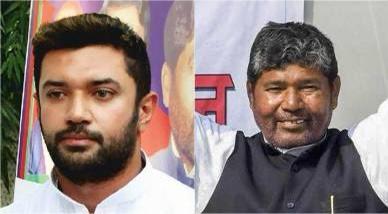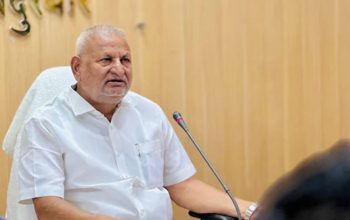Milind Dharmasena
New Delhi : Even as the two factions of former President of Lok Janshakti Party (LJP) Chirag Paswan and his uncle, Union Minister Pashupati Kumar Paras squabble for the LJP symbol `Bungalow’ the Election Commission of India (ECI) has resorted to the last option in such situations: freeze the symbol so that both the disputing parties don’t get to use it.

Chirag had staked claim to the party symbol for the upcoming Bihar assembly by polls to Kusheshwar Asthan, a reserved seat and Tarapur in Bihar scheduled on October 30. The crisis in the LJP began when five MPs switched from Chirag’s to Paras camp in June this year. Later,Paras declared himself as the party president in Patna.
In an order issued on October 2, the ECI said: “Both the groups shall be known by such names as they may choose for their respective groups, including, if they so desire, linkage with their parent party LJP. Neither of the two groups shall also be permitted to use the symbol “Bungalow”, reserved for the party. Both the groups shall also be allotted such different symbols as they may choose from the list of free symbols notified by the Election Commission for the purposes of the current by-elections.”
The tussle between Chirag and Paras started in June this year, when the latter claimed support of four of the five remaining MPs of the LJP barring Chirag, and removed Chirag as the parliamentary party leader. Paras claimed he was “not breaking the party”, but “saving it”. Thereafter, the Paras faction said it had removed Chirag as LJP chief.
High profile splits and party symbols: In 2017, the ECI had issued an interim order freezing the “two leaves” symbol of the AIADMK saying both the warring factions of the party cannot use it for the prestigious by-poll to R K Nagar assembly constituency in Tamil Nadu. The by-poll had been necessitated following the demise of Tamil Nadu Chief Minister J Jayalalithaa.
The most high-profile split of a party before the Symbols order of 1968 was that of the CPI in 1964. A breakaway group approached the ECI in December 1964 urging it to recognise them as CPI(Marxist). They provided a list of MPs and MLAs of Andhra Pradesh, Kerala and West Bengal who supported them. The ECI recognised the faction as CPI(M) after it found that the votes secured by the MPs and MLAs supporting the breakaway group added up to more than 4% in the three states.
In 1969, former Prime Minister Indira Gandhi’s differences with a rival group within the Congress party came to a head with the death of President Zakir Hussain on May 3, 1969. The Congress old guard, led by K Kamaraj, Neelam Sanjeeva Reddy, S Nijalingappa and Atulya Ghosh, known as the Syndicate, nominated Reddy for the post. Indira, who was the Prime Minister, encouraged Vice-President V V Giri to contest as an Independent, and called for a “conscience vote” in defiance of the whip issued by party president Nijalingappa.
After Giri won, Indira was expelled from the Congress, and the party split into the “old” Congress (O–Organisation) led by Nijalingappa and the “new” Congress (R-Requisition) led by Indira. The “old” Congress retained the party symbol of a pair of bullocks carrying a yoke; the breakaway faction was given the symbol of a cow with its calf.



